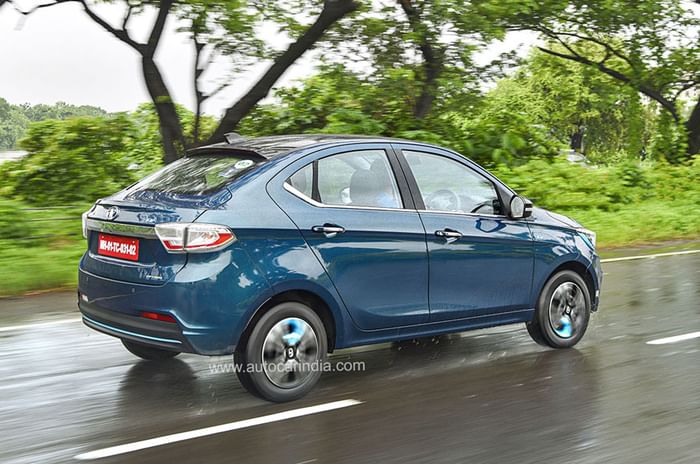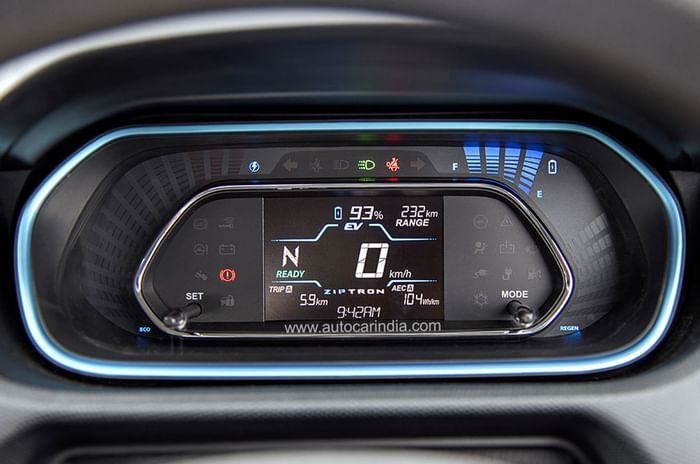Tata has long had an electric Tigor. Showcased at the 2018 Auto Expo, the electric compact sedan was launched the following year with a claimed range of 142km. And while it was initially available to commercial operators only, it was later sold to private buyers as well.
An update soon followed, which added an option of a higher capacity battery with an increased 213km range. Earlier this year, the facelifted Tigor EV was rechristened the Xpress-T, and restricted again for commercial use only. The Xpress-T’s lower-powered version also got an increase in its claimed range to 163km.

So, on the face of it, this is just another Tigor EV update. But it isn’t. In the world of EVs, more power and a bigger range is so much more important, and not only does the Tigor offer this, but where the Xpress-T carries on with the company’s older 72V electrical system, the 2021 Tigor EV now packs a 350V Ziptron EV system.
And then there’s the price. While not exactly cheap, at Rs 11.99 lakh, the Tigor EV is the most affordable private EV in India. Starting at Rs 9.75 lakh, the Xpress-T is cheaper but it’s sold to only commercial operators. There’s a lot to see then, so let’s begin with the biggest change – the Ziptron powertrain.
Power Up
The new Tigor EV’s battery capacity is 26kWh (for reference, the Xpress-T gets two sizes: 16.5kWh and 21.5kWh). It can be fast charged and on a 25kW DC charger, it can go from 0-80 percent in 65 minutes, while a standard 15A plug point will take 8 hours and 45 minutes for the same.
With the bigger battery, Tata claims an ARAI-certified range of 306km. While we will put it through our instrumented road test, our initial drive in and around Mumbai city saw us get between 1.9 to 2.1 km for every 1 percent of battery drop, so expect a range of around 180 to 200km. This isn’t enough for far-off weekend destinations but it’s certainly more than sufficient for daily city use. Do remember that if you dip below 25 percent on the battery, system power is reduced to help range.

Behind the wheel, the Tigor does feel like a proper electric car when compared to the Xpress-T. Performance is better but it’s not electrifying like we’ve come to expect from bigger – and yes, more expensive – EVs. That initial kick from an electric motor’s instant torque is missing and acceleration is flat and very sedate. Put your foot down and you get the feeling that the car’s system is carefully metering out its energy. The normal Drive mode is good only if you’re keeping pace with city traffic, if you want to hurry or even overtake, you’ll have to shift to Sport mode where the system makes full use of the 75hp, 170Nm motor to give you acceleration that’s peppy.

Tata says they’ve tuned the system to deliver a very measured rate of acceleration – keeping in mind that the car will mainly be used in the city – and also, naturally, to preserve charge. In our initial testing, we clocked a time of 14.88sec for the 0-100kph dash in Sport mode and an excruciatingly slow 29.28sec in Drive mode.
| 2021 Tata Tigor EV facelift: Performance | ||
|---|---|---|
| Speed (Sport Mode) | Tata Tigor EV* | Tata Nexon EV |
| 0-20kph | 1.97 sec | 1.51 sec |
| 0-40kph | 3.75 sec | 2.87 sec |
| 0-60kph | 6.08 sec | 4.36 sec |
| 0-80kph | 9.59 sec | 6.47 sec |
| 0-100kph | 14.88 sec | 9.30 sec |
*Not to Autocar India test standard
Brake energy recuperation is available, but it isn’t strong like in other EVs, and retardation on throttle lift-off feels similar to regular ICE cars. The regen level is also not adjustable and the mild intensity is essentially due to the smaller sized motor that has a limited capacity for regeneration.
Even Keel
Like the motor, the brakes also come across as laid back: they feel mushy and are quite uncommunicative, and get grabby when you press down. Braking performance is fine, but in our detailed testing it’s likely to show a longer stopping distance due to the extra weight the EV carries. The steering, on the other hand, is very nicely setup: it’s communicative, and light and easy in the city, while still being firm and reassuring at higher speeds. Ruts and bumps too do not throw it off course.


Grip from the 175-section tyres is also good and more than enough for what most owners will subject this car to. The only complaint would be that tyre noise at speed is on the higher side, and perhaps additional insulation would be better. That would, however, add weight, which is not something you want in an EV. Speaking of weight, Tata has to be commended for retaining the Tigor’s 4-star Global NCAP crash rating with the EV too. In a crash, the additional mass increases the load on the body shell, so Tata has re-engineered a few body points also provided additional strengthening to manage the extra 200kg. When considering the rise in the EV’s price, this should also be considered.
Comfort Zone
The insides look neat and are largely similar to the regular car, one difference being the large drive selector knob in place of the gear lever. While the rotary action is easy to use, you cannot go directly from Reverse to Drive or vice versa, you need to pass neutral – wait for the engagement beep – and only then shift ahead. This takes a second or two but is very annoying when you are trying to execute a quick three-point turn. Going from Drive to Sport mode, however, is quick.

The instrument panel is also different, with the dials replaced by an all-digital display. It has the usual lights and a digital speed readout, and while advanced EV-related info like battery graphs are absent, you get a range readout, a regen level indicator, battery gauge and percentage, a battery consumption readout showing Wh/km consumption, and a nice and large driving style indicator.

Also unique is the EV-themed colour detailing that is tastefully done with electric blue accents around the instrument panel, AC vents and on the seat fabric, where the stitching and tri-arrow pattern looks particularly nice. The plastics and overall quality do not reflect what you get in a Rs 10 lakh-plus car but that’s typically EV today, where they all offer less than comparable ICE cars. On its own though, the Tigor EV is decent enough and it has some good equipment in the form of a touchscreen with Android Auto and Apple CarPlay (though at 7 inches, it’s small by today’s standards), an auto AC, reverse camera, connected car tech and a superb sounding Harman
audio system.

The seats are large and comfy, though cushioning is soft. Space all round is good and will be sufficient for most, with enough head and legroom. Where the EV differs noticeably is in the boot. As the battery is placed below, the floor is now raised and the spare has moved inside. This has dropped boot space from 419 litres to 316 litres, but it has to be said that, with the spare tyre neatly mounted to one side, the available space is quite useable. The ground clearance hasn’t, reduced either and, at 172mm, the EV is 2mm higher than the ICE car.

As for the exterior, the EV is similar to the regular car and is nice and sharp looking. The grille is replaced by a flat panel with small cooling slots below, along with neat, embossed tri-arrows. There are different styled rims as well, which, along with other areas like the grille and bumpers, carry the electric blue accents and show its EV credentials.
Fair and Square
Summing up the Tigor EV is quite the task. To begin with, it’s electric and hence expensive. Even with healthy subsidies, like you get in Delhi, it’s still well over Rs 3 lakh more than its petrol-AMT counterpart; so, it’s best for those with higher running. By our calculations, you’ll need about four years to recover the difference if your running is about 1,000km per month, which is about 45km per day in a five-day week.

Then there’s Tata’s own Nexon EV. At just Rs 1 lakh more for the base and Rs 2 lakh more for a similarly equipped variant, the Nexon will attract some Tigor EV intenders with its bigger size, more power, and the allure and benefits of an SUV.
But the Tigor is not without its strengths or reason. For those with a higher running and who can avail of bigger subsidies, it makes a case for itself. The change in powertrain certainly makes this the best version of the Tigor: it retains nice bits like the space, ride and safety, and swaps out the lacklustre engine for a smoother and cleaner unit. Yes, the acceleration is slow but that’s not the point I guess. The Tigor EV is designed to be an easy-to-drive city commuter and it does that very well.
The compact dimensions are great in the city, the steering is nice and light, it’s decently equipped, and the performance is silent and smooth. Its range is also more than sufficient for daily city life. In fact, we wouldn’t be surprised if it pips the Nexon EV in our tests. So, it’s capable, clean and very safe; a car with good and noble intentions then, just like the customers who’d buy it.








































